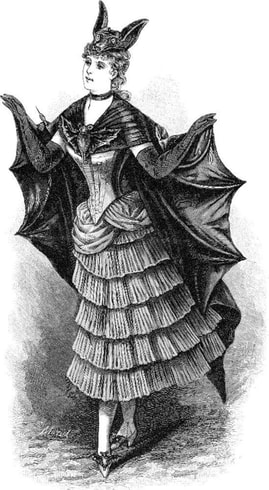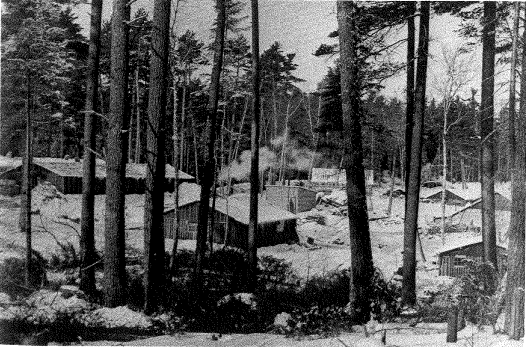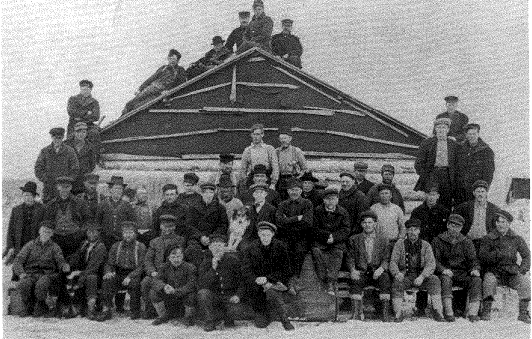|
Winter marked the start of the work season for lumberjacks. Cold temperatures meant the sap in the trees would be frozen, making it significantly easier to saw through them. Lumber camps in the northern woods of Minnesota, Wisconsin, and Michigan sprang to life in the fall as the log sheds, called "shanties" that the workers lived in were erected. The shanties were located as close to the pine trees as possible, to minimize the amount needed to travel in the harsh Midwestern winters. A fire located in the center of the shanties were burn continuously through the season to keep the cold at bay. Temperatures could easily reach -20° F, so staying warm and dry was highly important. Clothes and shoes would be hung up in the rafters of the shanties to dry overnight while the men slept. These workers would work from dawn until the sun set everyday but Sunday. Sunday was wash day and the men would launder their clothes, get their hair cut, and mend any clothes that had been torn. While it was their one day of rest, there was always work to be done around the camp. Food was eaten in the mess hall silently, as talking would distract the cooks and men from getting back to work. Typical meals consisted of pork, bread, beans, and molasses. Many camps kept their own pigs to have a supply of pork ready. Logging camps also had their own blacksmith and stores for workers to purchase daily needs. Horses were necessary for pulling the fallen logs back to camps and so having a blacksmith on site to shoes the horses was a necessity. To keep the sleighs moving, hay and dirt were dumped on gouges in the ice to help the horses and sleigh with traction. The saws used by the workers would need to be constantly refiled to stay sharp so one man was designated as the "filer". Personal items such as clothes, socks, tobacco, and knives were sold on site as well. Having all of the necessities taken care of at the camps made for more productive work as workers did not have to leave camp and travel. Come April when the ice on the rivers would thaw, the logs would be taken and placed on rafts to floated down the river. This marked the end of the work season for the lumberjacks. Some would return to towns that had sprung up around the logging camps and wait for the next season; others would travel elsewhere looking for more work. While the work was hard and in harsh conditions, it was necessary as people began to move further and further west and the demand for building materials rose.
 The Victorian era ushered in a new way to celebrate Halloween. Departing from previous decades of an All Saint’s Day that involved visiting the gravesites of loved ones that had passed and communing with the dead, Victorians subdued the holiday to fit in with a society concerned with morality, temperance, and quaint socializing. Halloween became a night of lavish partying with games that revolved around–of all things–romance. Periodicals in the 1870s and 1880s helped push Halloween as a night for frivolous divination games and socializing with friends. These publications were not unlike the ones we have today; they had articles on gossip, advice, and tips and tricks on relationships and keeping a home. Harper’s Weekly, Harper’s Bazaar, and Godey’s Lady’s Book were some of the most popular during this time. These magazines also published stories, poems, and many other short stories to entertain the Victorian middle-class. In just a few short years, Halloween parties were all the rage due to the influence of these magazines on middle-class families. Halloween parties were a staple for many young upper- and middle-class Victorians. By the 1890s, newspapers and other periodicals were printing ideas for games, recipes, and decorations to celebrate the holiday. Even invitations were extravagant; some hostesses would leave small jack-o’lanterns with invitations on the doorsteps of their party guests. Guests would dress in their best clothes and costumes as the parties also served as a matchmaking opportunity. Divination games played during Halloween mostly focused on love and match-making. One such game involved young women looking into mirrors, or scrying, to see the face of their future husband. Another game was to bob for apples and whomever was able to pick one up first, would be next to marry. Many other games included using different objects to find your spouse’s initials, what their silhouette looked like, their career, and even the colors of their alma mater college. While Victorians did still hold superstitions, many of the games were only played for fun and not taken seriously. By the 1910’s, Halloween began to fall out of fashion with adults. No longer were adults hosting these match-making parties as a growing industrial sector changed how many people worked and lived. The periodicals that once shared tips on how to celebrate Halloween turned to more intellectual topics of history and politics. Adults no longer found it suitable to play games and dress up. Halloween had officially turned into a children’s holiday. |
ArchivesCategories
All
|


 RSS Feed
RSS Feed